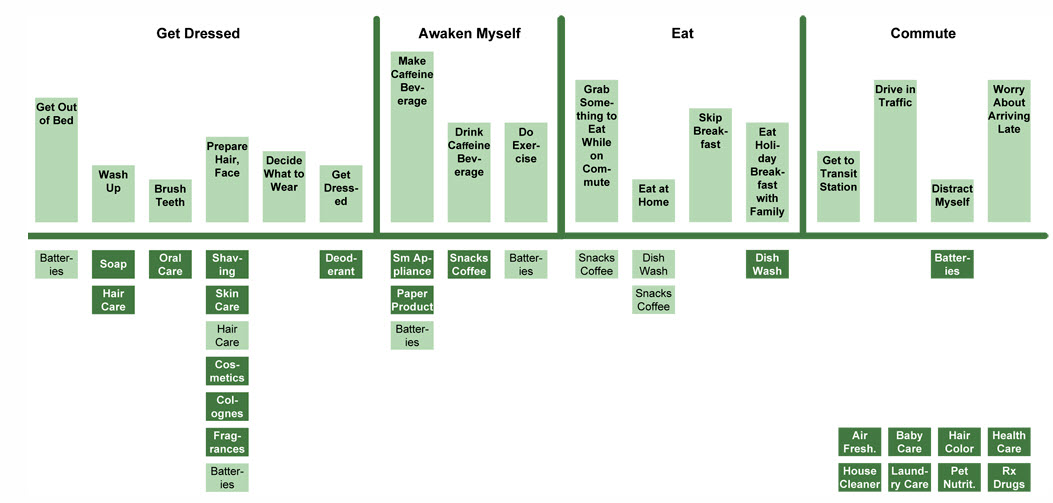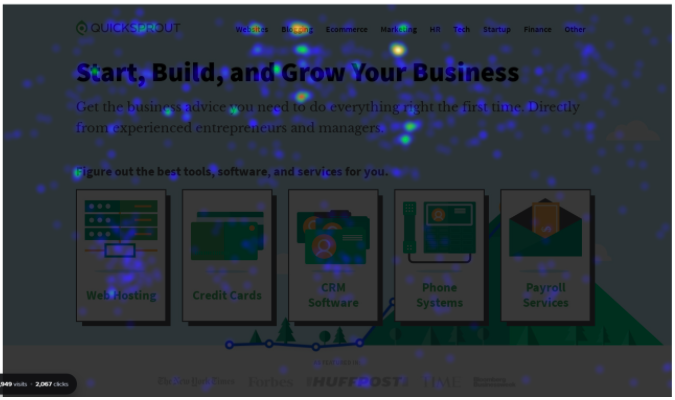“Much of this article is adapted or excerpted from the book Mental Models: Aligning Design Strategy with User Behavior by Indi Young (Rosenfeld Media, 2008).”
Designing something right requires that you completely understand what a person wants to get done. You need to understand how a person uses something if you’re going to get the design right for them. You also need to know the person’s goals and the procedures she/he follows to accomplish those goals.
Mental models give you a deep understanding of people’s motivations and thought processes along with the emotional and philosophical landscape in which they are operating.
Let’s begin with a simple mental model that might be used by a company like Procter and Gamble to determine the needs of its market on a typical work or school day.
Click to enlarge

Mental models guide the design of your solution and help you and your team make good user and business decisions by focusing your solution on what users actually need – based on the feedback they have already given you.
They can also act as a road map, ensuring continuity of vision and opportunity. A mental model consists of several sections, with groups within each section.
Put simply, they are affinity diagrams of behaviors made from ethnographic data gathered from audience representatives. Affinity diagrams are groups of related things such as the groups of grocery items shown below.

Once you’ve made your mental models you then use it to understand how your current offerings (e.g. website, store front) do and do not support people. You can then devise your strategy going forward.
How does it really help me?
Essentially mental models give you three things:-
- Confidence in your design
- Clarity in direction
- Continuity of strategy
Confidence in your design
This means that you know that what you have built meets your users needs. Your confidence is based on the fact that you have a solid foundation of research on which design decisions have been made.
Clarity of direction
As a business, you need a “vision” and direction, and you need to examine the “whole experience” i.e. every customer interaction. You undertake this when building your mental models, gathering, analyzing and acting upon this information.
Businesses that pay attention to the entire spectrum of customer interaction and experience – and who get it right most of the time – are those that win attention and loyalty from their customers.
Because mental models depict the whole of the user’s environment, and doesn’t just focus on one aspect or service, it’s the whole experience. The entire experience feeds in to your vision for the business.
Below is the morning routine mental model with product categories from P & G added to begin fleshing out the vision moving forward.
Click to enlarge

For an experience to be considered successful, your customers have to be able to use it easily and desire to use it. There is often an emotional component to the use of things (such as your website) and mental models capture these emotions as well as the cognitive intent of the person or even cultural traits.
Only by meeting these needs can you be sure that you are giving the customers what they want – which of course has an impact on products. This is particularly important for eCommerce websites – where giving the customer what they want has a direct impact on sales figures.
Continuity of strategy
Once your mental models are in place, they become a guiding strategy for your digital teams for years to come. Employees come and go, but your models will live on and you can ensure your strategy is followed. Mental models of your audiences should be regularly re-visited in order to ensure your offerings are being kept inline with customer needs.
The three things that you can gain from mental models all lead to one thing – and that is increased competitive advantage.
Competitive Advantage
Given that you and your competitors offer similar products to similar audiences, one of the best ways to make sure that your business stands out – and thus gathers and keeps customers, is by offering a superior experience.
Mental models help focus your business on the top-line value. They help deliver greater value to your customers or create comparable value at lower costs. This adds to your competitive advantage.
So how do you do this?
Creating mental models is a team process. You create them through multiple workshops with team members and stakeholders in your organization, which helps develop understanding and innovation.
To begin,look at your audience and the type of tasks they undertake when interacting with your product. These task based audience segments are basically groups of people who do similar things.
Because you want to tailor your end solutions to fit each audience exactly, grouping audiences by differences in behavior is important. You then gather actual users and have a conversation with them, collecting their perspective. This is usually in the form of an interview or one on one research. Look into audience personality types as well to help define your audience more.

Next, analyze all of these conversations and composite them into a mental model diagram. Compare all of the things your solution is supposed to do with the different parts of the mental model diagram.
Be sure you create a separate mental model for each of the audience types you have. Then compare the separate mental models to see what commonalities there are, if any, that you need to cover in your solution or if the audiences in fact require different solutions.
Understanding the differences among the mental spaces of your audience segments will bring clarity to your design. Align the models with the concepts that they support.
You can do this with functionality (features) just as it exists, or functionality being planned – or you can play around with brainstorming new ideas. (See June Cohen’s book “The Unusually Useful Web Book” on how to run brainstorming sessions)
Then, step back and look at the whole picture with your team so you can develop your long term design vision. Once you have a vision you can start devising tactical solutions for high priority areas of the mental model.
Use your mental model diagrams to derive design decisions.
For example, if a tower in your diagram shows that people “collect pictures of renovated houses to mull over”, perhaps you could create an online scrapbook of renovated houses that they could engage with, study and even design their own – so that you can sell them DIY products or financing for a house renovation.
Following is a section of a mental model that might be useful for a website in the film industry.
On top are moviegoer behaviors and below that is the content that would be useful for moviegoers exhibiting that behavior.
Click to enlarge

For detailed advice, and step by step processes and guidelines are further discussed in Mental Models: Aligning Design Strategy with Human Behaviour by Indi Young available from Rosenfeld Media.






